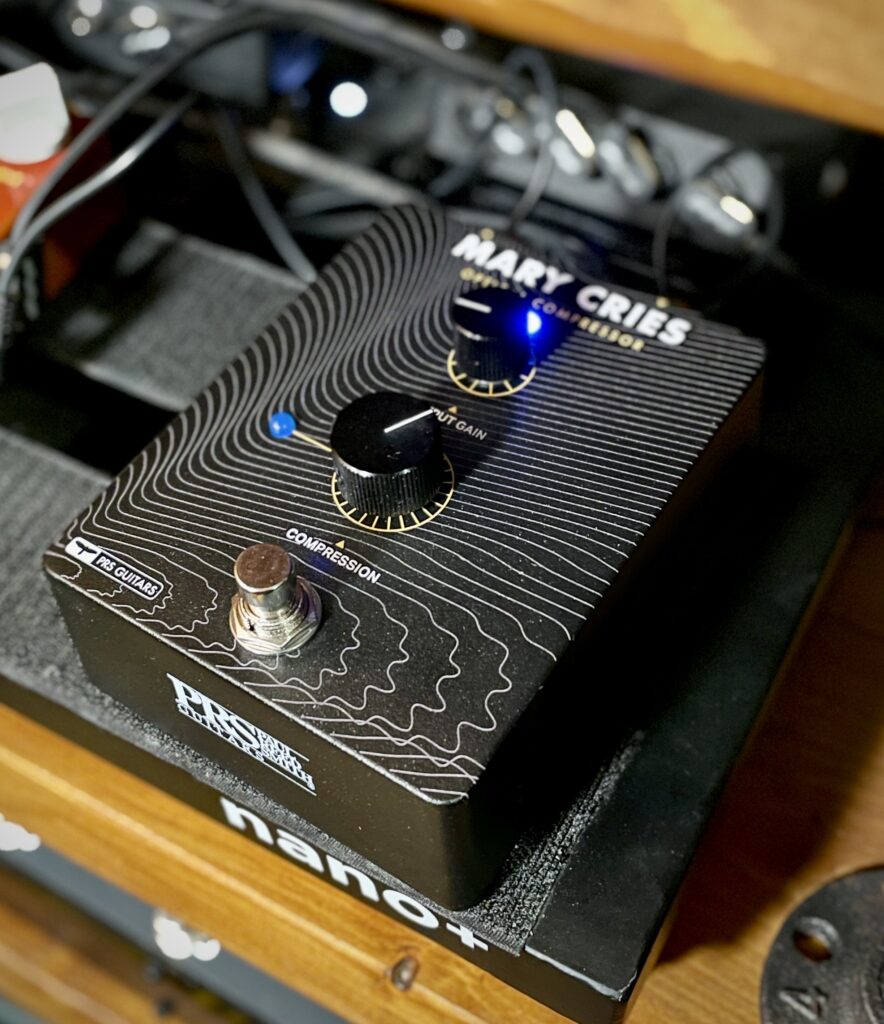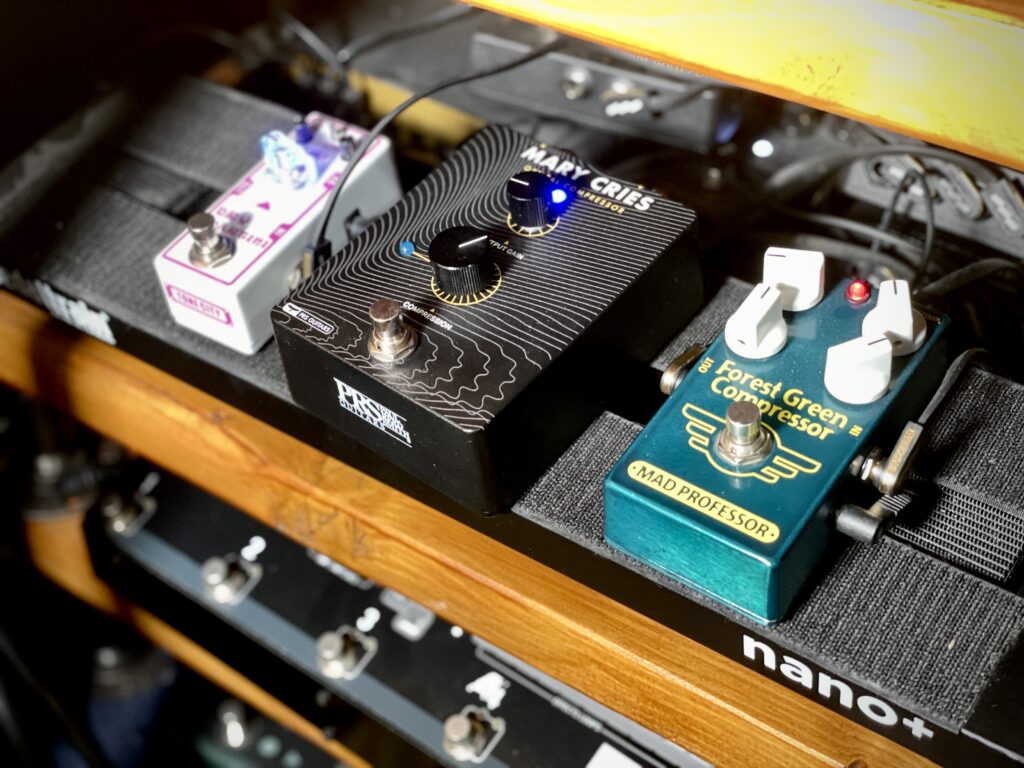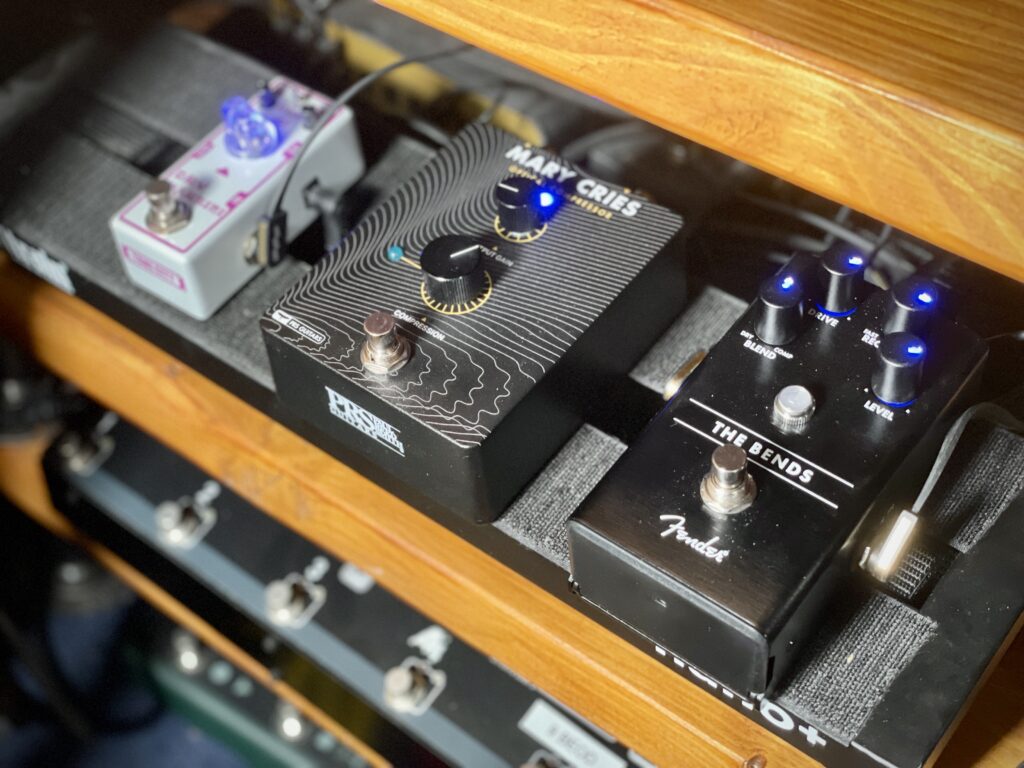At the end of September, seemingly out of the blue, PRS dropped their first three guitar pedals ever: an overdrive (the Horsemeat), a double-flanger (the Wind Through The Trees) and this one, an optical compressor (the Mary Cries).

Mine has just arrived. What do I think of it? Is it worth the price? Read on for my First Impressions.
What Did You Get?
I got a PRS Mary Cries optical compressor pedal.
I didn’t buy this. It was a combined Christmas / birthday present from Kristi. She has paid full price for it though.
Why Did You Get It?
When I started using pedals once again, my very first pedal was the Mad Professor Forest Green Compressor. I really love that pedal, so much so that (to this day) I own two of them. But as time as gone on, I’ve found myself reaching for it less and less.
I’ve tried a few other compressors over the years, but they’re either not transparent too, and/or they raise the noise floor far too much for me. I’ve got enough noise in my signal as it is. I’m not paying to add even more noise!
In the PRS sales / marketing demos for the Mary Cries, Paul Reed Smith talks about how they had to add a ‘compressor is compressing’ LED because they couldn’t tell when the Mary Cries pedal was doing something. Honestly, that caught my interest.
That sounded exactly like the compressor that I was looking for.
My Signal Chain Today
Today, I’m using:
- The Earl, my PRS Paul’s Guitar
- into the Axe-FX 3 (mostly for the digital tuner)
- out to my pedalboard
- back into the Axe-FX 3 (for amp, cab, delay and reverb)
- out to my audio interface
- and into my DAW.
On the pedalboard, I’ve got the Tone City Dry Martini overdrive pedal, the PRS Mary Cries compressor, the Mad Professor Forest Green Compressor and Fender’s The Bends compressor. They’re all in separate loops on my trusty Gigrig G2, so that they cannot affect the tone when they’re not being used.
All the effects that you hear are from the Axe-FX 3. I’m not using any plugins in my DAW. There is no post-processing at all.
Any noise that you hear in my audio examples is from my overall setup; it’s not caused by any of the compressor pedals that I’m writing about today.
Why I Rarely Use The Forest Green Compressor

The difficultly with the Forest Green Compressor is that it is far from transparent. It changes my guitar tone. To demonstrate that, here’s an audio demo:
There’s four examples in that single recording:
- Forest Green off
- Forest Green on
- Forest Green off again
- and finally Forest Green on to finish.
To my ears, the Forest Green Compressor is adding more upper mids and more low-end. I suspect the low-end build-up is just an artefact of the compressor’s design; I’ll come back to that topic towards the end of this blog post. The upper mids, though, I don’t think that’s caused by compression kicking in. I think that’s just the way the circuit changes the tone.
For several years, I really liked the way it shaped my tone. I still like having it on hand today. But these days, I’d rather shape the upper mids using a drive pedal. I don’t need my compressor to do this.
What About Fender’s The Bends Compressor?

Earlier in the year, I bought another compressor pedal: Fender’s The Bends. It’s pretty cheap for a compressor pedal. Sadly, it’s not as transparent as I’m looking for. To demonstrate that, here’s an audio demo:
Again, there are four examples in that single recording:
- The Bends off,
- The Bends on,
- The Bends off again,
- and finally, The Bends on to finish.
To my ears, it’s tonally transparent compared to the Forest Green Compressor. I think that’s easiest to hear on the fourth playing example in each audio demo. So that’s good.
Unfortunately, to get The Bends to compress, I find that I have to crank the pedal’s Drive control up towards 3 o’clock. At that point, it sounds like it’s adding distortion as well as compression.
It’s just not what I want from an always-on compressor pedal.
Mary Cries Is Far More Transparent
Here’s the same kind of audio demo as before, this time using the Mary Cries compressor:
Again, there are four examples in that single recording:
- Mary Cries off,
- Mary Cries on,
- Mary Cries off again
- and finally Mary Cries on to finish.
I don’t know about you, but to my ears, there’s very little difference between the sound when Mary Cries is off and on.
And that is exactly what I want from a compressor pedal.
Why Do You Want A Compressor Pedal?
A few years ago (2017?) I bought a Taylor T5z from Glasgow. Playing that guitar utterly changed my playing technique; I started regularly incorporating accented upstrokes into my rhythm playing.
These upstrokes have become an important part of my signature sound (if a mediocre guitar player can have a signature sound …), but my technique’s still a bit sloppy. I’ll often dig in a little too much, and that can cause unpleasant, unmusical spiky volume jumps.
The nice thing about a transparent compressor like the Mary Cries is that it just takes the top off these little picking errors, stopping them from causing a noticeable volume jump. Thanks to the very usable range on the Compression control, it isn’t taking away any of my picking dynamics either.
It just adds a little bit of polish to the performance, not to the tone.
Is It Really Transparent, Though?
To answer that, I’ve switched over to a different signal chain. Instead of running into the Dry Martini overdrive pedal, I’m now running into a pair of tweed-like amps. I think it’ll make any tonal differences much more obvious.
Here’s what that sounds like:
Once again, there’s four examples in the single recording, to make it easier to hear any tonal differences:
- Mary Cries off,
- Mary Cries on,
- Mary Cries off again,
- and finally, Mary Cries on to finish.
To my ears, when Mary Cries is on, the two amps sound thicker and a little darker. There’s a bit of a build-up in the low-end on the fourth piece in the audio.
Does that mean that the Mary Cries is not transparent? Or is this just a natural reaction of running a more compressed signal into two amps that are already naturally compressing? I’ve no idea.
The solution is to treat the Mary Cries as an always-on pedal, and just adjust the rest of the signal chain with this in mind. That’s what I am going to do.
I wouldn’t normally go with a tone that has this much low-end in it to begin with. The low-end is coming directly from the PRS Paul’s Guitar. When I did something about that low-end, things got very interesting indeed.
Did PRS Miss A Trick With The Mary Cries Compressor?
In the Axe-FX 3, I often run a multi-band compressor before the signal goes out to my pedal board. (This has been switched off for every audio demo you’ve heard so far in this blog post.) I just use it to take away the muddiness of the middle position on my PRS Paul’s Guitar.
When I switch this on (and make sure the lights are down low in the room), I can see that the Mary Cries is not compressing at all. The LED light is completely dark. I haven’t touched any of the settings.
I wasn’t expecting that.
That immediately begs the question: is the Mary Cries compressing from the full input signal, rather than from a filtered sidechain signal? Let me explain what I mean.
Studio compressors always act on the full input signal, but many of them can be configured to make their compression decisions from another signal. This is known as sidechain compression; where ‘sidechain’ refers to this other signal. Sometimes the sidechain comes from a completely separate input signal.
But, sometimes, it comes from a filtered version of the main input signal. These filtered sidechain signals exist to avoid the compressor being triggered by the low-end frequencies alone. That way, the compressor ends up acting only when the frequencies we’re targeting actually need compressing.
I’ve looked, and I can’t find any mention anywhere of whether or not the Mary Cries uses a filtered sidechain. If it did, I’d expect it to be listed as a feature; rival products from Empress Effects certainly do.
So, yeah … I can’t help but wonder if PRS missed a trick here.
Is It Expensive?
PRS market the Mary Cries as an LA-2A compressor in a box. As far as I can tell, there aren’t too many alternatives in pedal form:
- Union Tone make the LAB. It’s 80 USD more than the Mary Cries, and it doesn’t work off a regular pedal board power supply? Oh, and it doesn’t seem to be readily available over here.
- Effectrode make the PC-2A tube compressor. It’s about 30 GBP more than the Mary Cries, and it doesn’t work off a regular pedal board power supply. It is readily available over here, though.
If you know of any that I missed, please leave a comment below!
Compared to the alternatives, PRS seems to have priced the Mary Cries pretty well. It’s definitely costly, but it doesn’t seem to be expensive for what it is.
That said … at the time of writing, Thomann had listings for 55 compressor pedals that cost less than the Mary Cries. Go onto the second-hand market, and you’ll find even more choice available. Many guitarists are very happy with what these other compressor pedals offer. You might be too.
Final Thoughts
I’m not surprised that I’m very happy with the Mary Cries. At work, I’ve built a vocal processing chain for doing spoken word presentations. A key ingredient of that? Universal Audio’s LA-2A plugin.
This is the compressor pedal that I’ve been looking for. Now I need to work out how to incorporate it into my pedalboard as an always-on pedal.

Great review! Thank you
I have heard Paul say it compresses highs and leaves lows alone